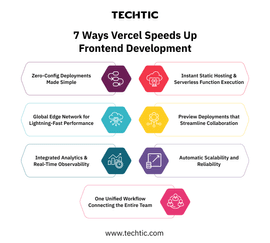7 Ways Vercel Accelerates Frontend Development
Sector: AI + Data
Author: Nisarg Mehta
Date Published: 09/09/2025

Contents
- Zero-Configuration Deployment
- Instant Static and Serverless Function Deployment
- Global Edge Network and Unmatched Performance
- Preview Deployments for Seamless Collaboration
- Built-in Analytics and Observability
- Automatic Scalability and Reliability
- A Unified Workflow for the Entire Team
- Final Words and Next Steps
- FAQs
So, what is Vercel? In simple terms, it’s a “Frontend Cloud” platform. It’s a company that created and maintains the popular web development framework Next.js, but their platform is what truly empowers businesses. Vercel is all about giving modern teams what they need to move quickly and build confidently.
In this article, we’re gonna dive deep into seven specific ways Vercel helps you move quicker. This way, you can stop getting bogged down by the tech stuff and just focus on what you’re actually here to do: building a great business.

1. Zero-Configuration Deployment
Remember the old way of doing things – you finally finish your code, and then, the real work begins. You’ve got to set up a server, configure all the little details, manage dependencies, and then, fingers crossed, pray that nothing breaks when you finally hit “deploy.” It’s just a huge time sink. And for a business owner, listen, time is definitely money.
But with Vercel, that whole headache just… disappears.
Vercel calls it “zero-configuration deployment.” Here’s how it works:
- You connect your Git repository, that’s GitHub, GitLab, or Bitbucket, and Vercel takes over.
- Right after you push your code, Vercel automatically detects what kind of project you’re building, whether it’s a slick Nextjs app or a simple React site.
- Vercel then builds it and deploys it, all by itself. You literally go from a line of code to a live website in seconds.
It saves a ton of developer time, for one, and it basically eliminates a major source of mistakes. No more wrestling with complex DevOps setups, you know? Your team can totally spend their time on what really matters: building awesome new features and creating a great experience for your customers. It’s not just some technical shortcut; it’s a genuine strategic advantage that gets you to market way, way faster.
2. Instant Static and Serverless Function Deployment
Back in the day, adding dynamic parts to a website meant spinning up a server that ran nonstop, even when nobody was using your site. You’d worry about cost, security updates, and endless maintenance. Vercel changes all that. The platform takes care of when and how your dynamic functions are run, so you can forget the behind-the-scenes hassle. They are masters of what’s called the “Jamstack,” which basically means they are all about super-fast static sites. But what about the dynamic stuff? That’s where Serverless Functions come in.
Serverless Functions are like tiny cloud computers that only fire up when you actually need them. They just sit there doing nothing, costing you zero dollars, until a user triggers something, like clicking “submit” on a form or adding an item to their cart. Vercel’s platform is optimized for this. It handles all the nitty-gritty details of running these functions for you.
And here’s the real benefit: you’re free from server management and standing costs. With Vercel’s “pay-as-you-go” model, you only pay for actual usage, a major win for teams who don’t want big bills or messy setups.
3. Global Edge Network and Unmatched Performance
You know how frustrating it is when a website takes forever to load? Or even worse, when it’s slow for customers on the other side of the country? That’s not just annoying; it hurts your bottom line. We’ve all heard that speed is a factor in SEO, but it goes way beyond that. It impacts conversions, bounce rates, all the things that matter to a business.
Vercel solves this with its Global Edge Network. Imagine having access to over a hundred datacenters scattered worldwide, Vercel calls these “Points of Presence.” Whenever someone pulls up your site, Vercel instantly serves your content from the datacenter closest to that visitor. It’s like having a mini store in every major city, even though you only built your site once!
The data backs this up, too. According to a commissioned study by Forrester, businesses that migrated to Vercel saw incredible results. We’re talking millions of dollars in incremental profits from higher website traffic and improved customer conversion rates. Why? Because a faster, more reliable website keeps people on the page and makes them more likely to buy. It’s that simple. This isn’t just a nice-to-have feature; it’s an absolute necessity for competing in today’s digital marketplace.
4. Preview Deployments for Seamless Collaboration
There’s a familiar moment on every product team: a developer ships a new feature, but before it’s ready to go, a designer, a manager, or even a client has to check it out and give feedback.
Instead of passing around clunky screenshots, setting up awkward demo environments, or recording walkthrough videos, Vercel brings real simplicity to the process.
As soon as code is pushed to a branch, Vercel launches a special preview link tailored to that exact version. It’s not just quick, it’s always on, acting like a personal staging site that updates automatically. Anyone who needs to see the latest change can open a special link, try out new features live in their own browser, and even leave comments right there. That way, feedback flows fast and directly, helping teams catch issues early and keep projects rolling smoothly.
5. Built-in Analytics and Observability
Let’s face it: launching isn’t the finish line. If your app is live, you can’t just assume it’s running well. Wild guesses don’t cut it. Teams need to see where visitors are coming from and how their site holds up under real traffic, without jumping through hoops to gather answers.
Vercel changes the equation with analytics and performance dashboards built right into the platform. Instantly, developers have the numbers that matter, site visits, patterns, and traffic spikes are all visible at a glance, along with unusual trends that could signal issues. Vercel puts all the essential numbers front and center. Instantly, you get trends, traffic spikes, and real user experience data without cobbling together different tools. So if something’s off, you spot it fast.
What’s more, these are the same quality signals that Google uses for rankings. Vercel’s dashboard gives you clear, instant feedback, LCP, FID, and CLS so you always know where you stand, both for users and for search.
6. Automatic Scalability and Reliability
Every entrepreneur loves a good traffic spike, whether it’s a viral moment or a big campaign going live. But nothing kills the celebration faster than a site crashing under pressure. Traditionally, you’d have to try to predict demand and rent more servers “just in case,” which is expensive and risky.
Vercel’s serverless setup means your app can adapt on its own, without you lifting a finger. Whether you’re getting a handful of visitors or millions, the platform flexes behind the scenes to meet demand automatically. You don’t have to tweak any settings, the infrastructure expands and contracts for you, and you’re billed only for what you use.
And it’s not just about scaling; it’s about reliability. Vercel’s Enterprise plan offers a 99.99% SLA-backed uptime, which is basically the gold standard. Vercel takes security seriously, packing in things like automatic HTTPS, powerful firewalls, and systems that fend off DDoS attacks. These protections run quietly in the background, so you can launch big marketing pushes or product updates without constantly worrying whether your site will crash under the pressure. That kind of trust in your platform is exactly what lets business folks sleep better at night.
7. A Unified Workflow for the Entire Team
Vercel really shines in how it unites everyone involved, whether you’re writing code, reviewing designs, or making product calls, the whole team is actually on the same page. It trims away the awkward handoffs so people can do their jobs without roadblocks.
Just picture it:
- Developers just push their commits to Git, and everything else happens automatically, no extra infrastructure chores.
- For designers, any update shows up instantly in a working preview, so they can spot issues or give feedback right away.
- Product managers and others can actually use those live previews to experience new features for themselves before launch, leaving notes or suggestions all along the way, no technical hoops to jump through.
Since everyone stays up to speed, there’s less confusion and more real progress. In fact, studies show Vercel users release new features much faster than on other platforms; most spend far less time worrying about set-up and maintenance. That kind of momentum isn’t just nice, it’s a huge edge. It means products launch sooner, teams react to feedback immediately, and customer experience improves because everyone’s rowing in the same direction.
Final Words and Next Steps
When you boil it down, Vercel feels less like a tool you have to manage and more like a partner you can trust, one that clears up the technical tangles so your crew can concentrate on building useful things and moving forward. Take deployments, for example, they’re automatic. Global delivery? Sorted. Teams always have an up-to-date view of where a project stands. That’s how new ideas get released with less stress and more speed.
Vercel doesn’t just promise these results: many businesses already using it are seeing serious benefits. A commissioned Forrester study found companies saved thousands of hours and saw over 260% ROI, thanks to reduced infrastructure management and quadruple the pace of enhancements getting out the door.
For you, the entrepreneur, this means:
- Your ideas can go from concept to live site in a matter of seconds.
- You only pay for what you actually use, no need for a big DevOps squad.
- Your site stays speedy, keeping both visitors and search engines happy.
So, if you want your websites to run on the best engines so you can rely on them, you should opt for Vercel. Technical support companies like Techtic solutions can help you leverage Vercel for your websites. Feel free to reach out to our experts to get started.
FAQs
Q: What is Vercel and why is it important for frontend development?
Vercel is a cloud platform designed for frontend frameworks and static sites, best known as the creator of Next.js. It simplifies deployments, improves site speed with a global edge network, and provides tools like serverless functions and preview environments. For developers, this means less time on DevOps and more focus on building fast, scalable, and user-friendly applications.
Q: How does Vercel improve website performance?
Vercel boosts performance by serving content through its Global Edge Network, which delivers assets from the data center closest to the user. Combined with optimized static site generation and serverless functions, this setup reduces latency, improves Core Web Vitals, and enhances SEO rankings, all while delivering a seamless user experience across devices and regions.
Q: What are the main benefits of using Vercel over traditional hosting?
Unlike traditional hosting, Vercel offers:
- Zero-configuration deployment straight from GitHub, GitLab, or Bitbucket.
- Serverless functions that scale automatically without server management.
- Preview deployments for real-time collaboration.
- Built-in analytics to monitor performance and user behavior.
- Automatic scalability to handle traffic spikes without downtime.
These features make Vercel a future-ready platform for businesses and developers.
Q: Is Vercel scalable for enterprise-level applications?
Yes. Vercel offers automatic scalability to handle traffic spikes and enterprise-grade features like a 99.99% uptime SLA, DDoS protection, and advanced security. Enterprises benefit from a reliable, high-performance infrastructure without needing to over-provision servers. This makes Vercel ideal for startups as well as large-scale enterprise applications.
Q: How does Vercel save costs for businesses?
Vercel follows a pay-as-you-go model, meaning businesses only pay for actual usage instead of maintaining costly servers. Serverless functions run only when triggered, and static content is served at minimal cost. By eliminating heavy infrastructure management and DevOps overhead, businesses achieve faster ROI and lower operating expenses.



